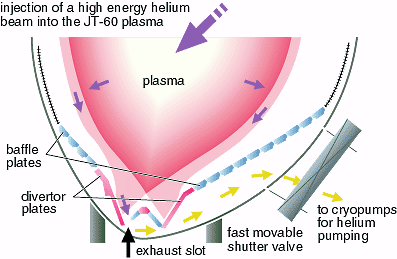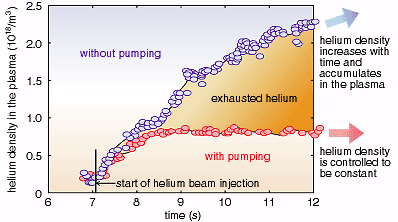As part of the JT-60 program for the research and development
of a steady-state tokamak fusion reactor, we successfully demonstrated
(in JT-60) the effective removal of helium ash from a reactor
core using a new type of divertor modified last year. While the
high energy helium ions produced from deuterium and tritium fusion
reactions are essential for heating the core plasma and maintaining
the fusion burning in a DT fusion reactor, the slowed-down helium
ions having temperatures as low as those of the fuel deuterium
and tritium ions should be removed efficiently, as helium ash
from the reactor core. This is indispensable to avoid fuel dilution
by helium ash accumulation in the reactor core; otherwise the
fusion reactivity or the fusion output will decrease.
The new divertor is a pumped divertor with cryopumps, having a
W-shaped structure with inclined divertor plates and a dome and
baffle plates to reduce the back flow of neutral particles towards
the main plasma, and is located at the bottom of the vacuum vessel
as shown in Fig. 2-1. The overall design was intended to meet
the performance require-ments of the International Thermonuclear
Experimental Reactor (ITER) divertor.
The behavior of helium ions in a DT fusion reactor was simulated
by injecting a high energy beam of helium atoms continuously into
the core of the JT-60 plasma that has slightly deteriorated confinement
at the boundary, a condition preferable for steady-state operation.
Figure 2-2 shows the time evolution of helium density in the plasma
with and without helium pumping at the divertor. The result indicates
that the helium concentration in the main plasma can be controlled
well within the range of the ITER design requirements (less than
10%) considered to be necessary for the successful operation of
a future fusion reactor. |

